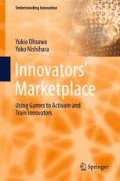Abstract
Successful companies understand and respond to the latent demands of customers. “Chance discovery” means, as stated previously, the discovery of events essential for making decisions (Ohsawa and McBurney 2003). In this chapter, we describe a method of chance discovery in which visual/touchable tools for data-based decision making are positioned in the spiral of human–machine collaboration in a business environment. We present a case of an actual business using this method to choose the most promising textile products for production and sale in the real market. The results are evaluated on the basis of the subjective criteria of business people rather than the objective criteria of a computer, and the evaluation is then passed on to the next cycle in the process of chance discovery, thereby improving the business performance.
Access this chapter
Tax calculation will be finalised at checkout
Purchases are for personal use only
Notes
- 1.
KeyGraph®; is registered trademark of Yukio Ohsawa of the University of Tokyo, Japan.
References
Evans J (1987) Bias in human, reasoning: causes and consequences. Erlbaum, Hillsdale
Fine C (1998) Clockspeed. Linda Michaels, Lakeville
Greenacre MJ (1993) Correspondence analysis in practice. Academic Press, London
Han J, Kamber M (2001) Data mining concept and techniques. Academic Press, London
Horie K, Ohsawa Y (2006) Product designed on scenario maps using pictorial KeyGraph. WSEAS Trans Inf Sci Appl 3(7):1324–1331.
Joshi MV (2002) On evaluating performance of classifiers for rare classes. ICDM 2002, Maebashi City, pp 641–644
Lance GN, Williams WT (1967) A general theory of classificatory sorting strategies, I. Hierarchical systems. Comput J 9:373–380
Matsuo Y, Ohsawa Y (2002) Finding the meaning of clusters. In: AAAI fall symposium on chance discovery technical report FS-02-01. AAAI Press, California, pp 7–13
Ohsawa Y (2003a) Modeling the process of chance discovery. In: Ohsawa Y, McBurney P (eds) Chance discovery. Springer, Berlin, pp 2–15
Ohsawa Y (2003b) KeyGraph: visualized structure among event clusters. In: Ohsawa Y, McBurney P (eds) Chance discovery. Springer, Berlin, pp 262–275
Ohsawa Y, Fukuda H (2002) Chance discovery by stimulated group of people, an application to understanding rare consumption of food. J Conting Crisis Manag 10(3):129–138
Ohsawa Y, McBurney P (eds) (2003) Chance discovery. Springer, Berlin/New York
Quinlan JR (1993) C4.5 Programs for machine learning. Kaufmann, San Mateo
Roussopoulos N, Kelley S, Vincent F (1995) Nearest neighbor queries. In: Proceedings of the 1995 ACM-SIGMOD international conference on management of Data, San Jose, 1995, pp 71–79
Soukup T (2002) Visual data mining: techniques and tools for data – visualization and mining. Wiley, New York
Sumi Y, Mase K (2003) Enhancing daily conversations. In: Ohsawa Y, McBurney P (eds) Chance discovery. Springer, Berlin, pp 305–323
von Hippel E (2006) Democratizing innovation. MIT Press, Cambridge
Weiss GM, Hirsh H (1998) Learning to predict rare events in event sequences. In: Proceedings of international conference KDD’98. AAAI Press, California, pp 359–363
Author information
Authors and Affiliations
Corresponding author
Rights and permissions
Copyright information
© 2012 Springer-Verlag Berlin Heidelberg
About this chapter
Cite this chapter
Ohsawa, Y., Nishihara, Y. (2012). Using Maps for Scenario Externalization. In: Innovators' Marketplace. Understanding Innovation. Springer, Berlin, Heidelberg. https://doi.org/10.1007/978-3-642-25480-2_3
Download citation
DOI: https://doi.org/10.1007/978-3-642-25480-2_3
Published:
Publisher Name: Springer, Berlin, Heidelberg
Print ISBN: 978-3-642-25479-6
Online ISBN: 978-3-642-25480-2
eBook Packages: Business and EconomicsBusiness and Management (R0)

